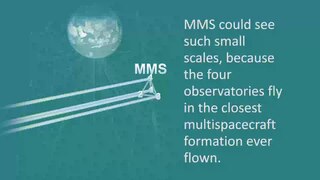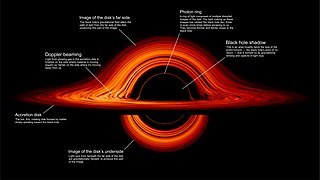Related Research Articles

A corona is the outermost layer of a star's atmosphere. It is a hot but relatively dim region of plasma populated by intermittent coronal structures known as solar prominences or filaments.

Magnetohydrodynamics is a model of electrically conducting fluids that treats all interpenetrating particle species together as a single continuous medium. It is primarily concerned with the low-frequency, large-scale, magnetic behavior in plasmas and liquid metals and has applications in numerous fields including geophysics, astrophysics, and engineering.

The nebular hypothesis is the most widely accepted model in the field of cosmogony to explain the formation and evolution of the Solar System. It suggests the Solar System is formed from gas and dust orbiting the Sun which clumped up together to form the planets. The theory was developed by Immanuel Kant and published in his Universal Natural History and Theory of the Heavens (1755) and then modified in 1796 by Pierre Laplace. Originally applied to the Solar System, the process of planetary system formation is now thought to be at work throughout the universe. The widely accepted modern variant of the nebular theory is the solar nebular disk model (SNDM) or solar nebular model. It offered explanations for a variety of properties of the Solar System, including the nearly circular and coplanar orbits of the planets, and their motion in the same direction as the Sun's rotation. Some elements of the original nebular theory are echoed in modern theories of planetary formation, but most elements have been superseded.

A coronal mass ejection (CME) is a significant ejection of magnetic field and accompanying plasma mass from the Sun's corona into the heliosphere. CMEs are often associated with solar flares and other forms of solar activity, but a broadly accepted theoretical understanding of these relationships has not been established.

In plasma physics, an Alfvén wave, named after Hannes Alfvén, is a type of plasma wave in which ions oscillate in response to a restoring force provided by an effective tension on the magnetic field lines.
In plasma physics, magnetic helicity is a measure of the linkage, twist, and writhe of a magnetic field.

Magnetic reconnection is a physical process occurring in electrically conducting plasmas, in which the magnetic topology is rearranged and magnetic energy is converted to kinetic energy, thermal energy, and particle acceleration. Magnetic reconnection involves plasma flows at a substantial fraction of the Alfvén wave speed, which is the fundamental speed for mechanical information flow in a magnetized plasma.
Eric Ronald Priest is Emeritus Professor at St Andrews University, where he previously held the Gregory Chair of Mathematics and a Bishop Wardlaw Professorship.
Computational magnetohydrodynamics (CMHD) is a rapidly developing branch of magnetohydrodynamics that uses numerical methods and algorithms to solve and analyze problems that involve electrically conducting fluids. Most of the methods used in CMHD are borrowed from the well established techniques employed in Computational fluid dynamics. The complexity mainly arises due to the presence of a magnetic field and its coupling with the fluid. One of the important issues is to numerically maintain the (conservation of magnetic flux) condition, from Maxwell's equations, to avoid the presence of unrealistic effects, namely magnetic monopoles, in the solutions.
The magnetorotational instability (MRI) is a fluid instability that causes an accretion disk orbiting a massive central object to become turbulent. It arises when the angular velocity of a conducting fluid in a magnetic field decreases as the distance from the rotation center increases. It is also known as the Velikhov–Chandrasekhar instability or Balbus–Hawley instability in the literature, not to be confused with the electrothermal Velikhov instability. The MRI is of particular relevance in astrophysics where it is an important part of the dynamics in accretion disks.
Coronal seismology is a technique of studying the plasma of the Sun's corona with the use of magnetohydrodynamic (MHD) waves and oscillations. Magnetohydrodynamics studies the dynamics of electrically conducting fluids - in this case the fluid is the coronal plasma. Observed properties of the waves (e.g. period, wavelength, amplitude, temporal and spatial signatures, characteristic scenarios of the wave evolution, combined with a theoretical modelling of the wave phenomena, may reflect physical parameters of the corona which are not accessible in situ, such as the coronal magnetic field strength and Alfvén velocity and coronal dissipative coefficients. Originally, the method of MHD coronal seismology was suggested by Y. Uchida in 1970 for propagating waves, and B. Roberts et al. in 1984 for standing waves, but was not practically applied until the late 90s due to a lack of necessary observational resolution. Philosophically, coronal seismology is similar to the Earth's seismology, helioseismology, and MHD spectroscopy of laboratory plasma devices. In all these approaches, waves of various kind are used to probe a medium.
Magnetohydrodynamic turbulence concerns the chaotic regimes of magnetofluid flow at high Reynolds number. Magnetohydrodynamics (MHD) deals with what is a quasi-neutral fluid with very high conductivity. The fluid approximation implies that the focus is on macro length-and-time scales which are much larger than the collision length and collision time respectively.

AZ Cancri (AZ Cnc) is a M-type flare star in the constellation Cancer. It has an apparent visual magnitude of approximately 17.59.

An accretion disk is a structure formed by diffuse material in orbital motion around a massive central body. The central body is most frequently a star. Friction, uneven irradiance, magnetohydrodynamic effects, and other forces induce instabilities causing orbiting material in the disk to spiral inward toward the central body. Gravitational and frictional forces compress and raise the temperature of the material, causing the emission of electromagnetic radiation. The frequency range of that radiation depends on the central object's mass. Accretion disks of young stars and protostars radiate in the infrared; those around neutron stars and black holes in the X-ray part of the spectrum. The study of oscillation modes in accretion disks is referred to as diskoseismology.

Supra-arcade downflows (SADs) are sunward-traveling plasma voids that are sometimes observed in the Sun's outer atmosphere, or corona, during solar flares. In solar physics, arcade refers to a bundle of coronal loops, and the prefix supra indicates that the downflows appear above flare arcades. They were first described in 1999 using the Soft X-ray Telescope (SXT) on board the Yohkoh satellite. SADs are byproducts of the magnetic reconnection process that drives solar flares, but their precise cause remains unknown.
In planetary science a streaming instability is a hypothetical mechanism for the formation of planetesimals in which the drag felt by solid particles orbiting in a gas disk leads to their spontaneous concentration into clumps which can gravitationally collapse. Small initial clumps increase the orbital velocity of the gas, slowing radial drift locally, leading to their growth as they are joined by faster drifting isolated particles. Massive filaments form that reach densities sufficient for the gravitational collapse into planetesimals the size of large asteroids, bypassing a number of barriers to the traditional formation mechanisms. The formation of streaming instabilities requires solids that are moderately coupled to the gas and a local solid to gas ratio of one or greater. The growth of solids large enough to become moderately coupled to the gas is more likely outside the ice line and in regions with limited turbulence. An initial concentration of solids with respect to the gas is necessary to suppress turbulence sufficiently to allow the solid to gas ratio to reach greater than one at the mid-plane. A wide variety of mechanisms to selectively remove gas or to concentrate solids have been proposed. In the inner Solar System the formation of streaming instabilities requires a greater initial concentration of solids or the growth of solid beyond the size of chondrules.
Blakesley Burkhart is an astrophysicist. She is the winner of the 2017 Robert J. Trumpler Award awarded by the Astronomical Society of the Pacific, which recognizes a Ph.D. thesis that is "particularly significant to astronomy." She also is the winner of the 2019 Annie Jump Cannon Award in Astronomy and the 2022 winner of The American Physical Society's Maria Goeppert-Mayer Award. The awards both cited her work on magnetohydrodynamic turbulence, and for developing innovative techniques for comparing observable astronomical phenomena with theoretical models.
William Henry Matthaeus is an American astrophysicist and plasma physicist. He is known for his research on turbulence in magnetohydrodynamics (MHD) and astrophysical plasmas, for which he was awarded the 2019 James Clerk Maxwell Prize for Plasma Physics.
The Waves in the Lower Solar Atmosphere (WaLSA) team is an international consortium focused on investigating wave activity in the Sun's lower atmosphere. The team's research seeks to understand how magnetohydrodynamic (MHD) waves generated within the Sun's interior and lower atmosphere influence the dynamics and heating of its outer layers.
References
- ↑ "pencil-code/pencil-code". GitHub.com. 4 May 2022. Retrieved 26 May 2022.
- ↑ Johansen, A.; Oishi, Jeffrey S.; Mac Low, M.-M.; Klahr, H.; Henning, Th.; Youdin, A. (2007). "Rapid planetesimal formation in turbulent circumstellar disks". Nature. 448 (7157): 1022–1025. arXiv: 0708.3890 . Bibcode:2007Natur.448.1022J. doi:10.1038/nature06086. PMID 17728751. S2CID 4417583.
- ↑ Käpylä, P. J.; Mantere, M. J.; Brandenburg, A. (2012). "Cyclic magnetic activity due to turbulent convection in spherical wedge geometry". Astrophys. J. 755 (1): L22. arXiv: 1205.4719 . Bibcode:2012ApJ...755L..22K. doi:10.1088/2041-8205/755/1/L22. S2CID 8254781.
- ↑ Heinemann T.; Dobler W.; Nordlund Å.; Brandenburg A. (2006). "Radiative transfer in decomposed domains". Astronomy & Astrophysics. 448 (2): 731–737. arXiv: astro-ph/0503510 . Bibcode:2006A&A...448..731H. doi:10.1051/0004-6361:20053120. S2CID 13930792.
- ↑ Bourdin Ph.-A.; Bingert S.; Peter H. (2013). "Observationally driven 3D magnetohydrodynamics model of the solar corona above an active region". Astronomy & Astrophysics. 555: A123. arXiv: 1305.5693 . Bibcode:2013A&A...555A.123B. doi:10.1051/0004-6361/201321185. S2CID 56246517.
- ↑ Lyra. W.; Kuchner, M. J. (2013). "Formation of sharp eccentric rings in debris disks with gas but without planets". Nature. 499 (7457): 184–187. arXiv: 1307.5916 . Bibcode:2013Natur.499..184L. doi:10.1038/nature12281. PMID 23846656. S2CID 659529.
- ↑ Brandenburg A.; Dobler W. (2002). "Hydromagnetic turbulence in computer simulations". Comput. Phys. Commun. 147 (1–2): 471–475. arXiv: astro-ph/0111569 . Bibcode:2002CoPhC.147..471B. doi:10.1016/S0010-4655(02)00334-X. S2CID 14808329.
- ↑ Bourdin Ph.-A. (2020). "Driving solar coronal MHD simulations on high-performance computers". Geophys. Astrophys. Fluid Dyn. 114 (1–2): 235–260. arXiv: 1908.08557 . Bibcode:2020GApFD.114..235B. doi:10.1080/03091929.2019.1643849. S2CID 201253269.